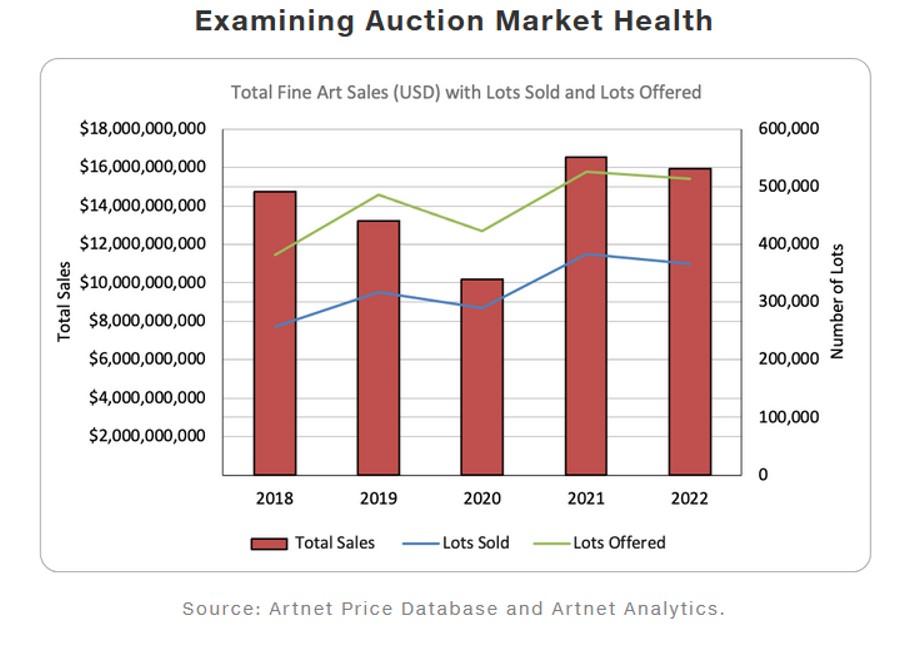[ad_1]

The world of art auctions, which can be fascinating in its own right, also has lessons for the wider wealth management industry. The editor takes a look.
More than three years ago when the pandemic hit, in-person art
auctions, fairs and gallery exhibitions closed their doors, and
only a part of that business was able to migrate to a virtual
world. And for all the breathless talk about how so much of our
lives are moving online, it turns out that people really do need
to see and enjoy art in the flesh.
The Art Basel and UBS Global Art Market Report,
published last week, noted that during 2022, the event-driven
market resumed its more regular schedule. Dealers and auction
houses reported a further cut in the share of their sales
accounted for by e-commerce in 2022. Following two years of
unprecedented growth, online-only sales fell to $11 billion in
2022, a 17 per cent decline year-on-year from their peak of $13.3
billion in 2021, although still 85 per cent higher than in 2019.
What such data suggests is that while the online auction and
sales channels are becoming more important, people in this sphere
are keen to enjoy the hustle and bustle of in-person events. That
doesn’t mean that some of the transactions they get involved with
won’t have an online element, but it does suggest that they want
to view art “in the flesh,” as it were, as much as is
feasible.
As we noted in the report when it came out, events such as art
auctions and exhibitions can be barometers for how prosperous –
or not – high net worth individuals think they are and how
willing they are to splash out and enjoy the wealth they have.
And beyond the aesthetic enjoyment, there’s also the investment
angle – returns on some forms of art can be strong in certain
periods.
There’s been a recovery, for sure, in art sales since the
annus terriblis of 2020. In another report, by Morgan
Stanley and Artnet News (March 2023), total sales
of fine art reached $15.9 billion in 2022, a roughly 4 per cent
decline from the $16.4 billion sold in 2021 but still the second
highest annual total since 2018. The report’s authors said this
result is noteworthy because its five-year sample includes two
pre-pandemic years and two post-pandemic years bookending an
“anomalous” 2020.

The virtual model of exhibitions in the art and museum world
hasn’t gone away, however. Even without a pandemic, not everyone
can afford the time to fly to a museum or gallery, and technology
is now so good it is possible to see artistic wonders over a
screen. I’ve taken a virtual tour around the Vatican, for
example. The Getty Research Institute has a suite of virtual
exhibitions on subjects as varied as Indian cities to Bauhaus
archictecture. You can go on a virtual tour of spaces such as the
National Gallery in London or some of the houses designed by
Frank Lloyd Wright.
Beyond marvelling at the technical wizardry of all this, what
lessons are there for wealth managers? Even before Covid-19
struck, there was much talk and some action on the digitalisation
of value chains, wider use of interactive videos, “gamification”
of the client experience, and augmentation of RMs with more
tools. None of these developments have lost force – the
pandemic accelerated them. There has also been a squeeze of sorts
– people think that bit harder about whether a business trip or
in-person meeting is worth the time on the road or the flight.
Where budgets are tight, in-person events will have to be more
fun, and generate more return on investment than before.
Gone are the days, I suspect, of interminable business
conferences where delegates had to listen to people mouthing
clichés about “client-centric offerings” and the like, then rush
to network over bad coffee. Families will have meetings to
discuss the financial stuff over Zoom or Teams, but will go for
the quality time together for a bit of fun instead. I see this
happening in our own industry quite a lot: wealth managers love
to hang out with others and swap stories and gossip, but they
want more value out of this than, say, 10 years ago. It means
putting on events that require more work, more imagination,
and more willingness to try something different.
Back in the early weeks of the pandemic, it was possible to buy
into the whole idea that physical events would be off-limits for
years, and that people would only reluctantly attend them.
The psychological as well as economic impact of lockdowns cannot
be underestimated. But it does appear, from where I sit now in
April 2023, that the appetite to “get out there” and meet people
has largely returned. That”s an optimistic note on which to
conclude.
As ever, if you have reactions, suggestions or stories for us,
email me at tom.burroughes@wealthbriefing.com
[ad_2]
Source link
